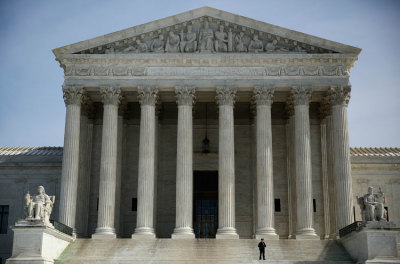US Supreme Court: Can Government Restrict How a Church Can Use Signs?

On January 12th, I attended Supreme Court oral arguments in a case—Reed v. Town of Gilbert—which will determine how easily the government can restrict signs giving directions to church services. Specifically, the Court is set to decide whether, under free speech protections of the First Amendment, a local government's mere assertion that its sign code (despite on its face discriminating based on content) lacks a discriminatory motive renders the sign code content-neutral and justifies the code's differential treatment of signs pointing the way to a church's meeting location.
In this case, the Town of Gilbert had divided signs up based on whether they were ideological, political, or directional—and imposed different restrictions on each category of sign. Good News Community Church in Gilbert, Arizona, and its pastor, Clyde Reed, sued, claiming that signs pointing the way to their Sunday morning service (which contained religious speech and directions, and thus resulted in them being placed in the directional sign category) were treated less fairly and that this unfair treatment violated the First Amendment.
At oral arguments, both sides received their fair share of questions, but the justices were noticeably more skeptical of the town's argument—especially its claim that it could severely restrict a sign containing ideological content announcing an event if the sign also included directions to that event, while at the same time easing restrictions on a sign containing the same exact ideological content and yet lacking directions.
The town attempted to defend itself by arguing it had an interest in preventing roadside clutter arising from numerable directional signs. But then it admitted it was granting preference to ideological and political signs because of the special First Amendment protection offered them, which prompted questions from the justices asking how the town was not impermissibly discriminating based on the content of the signs.
A breakthrough moment occurred when the town's counsel admitted under questioning by Justice Breyer that the town could put up a sign saying: "Come to the next service next Tuesday, 4th and H Streets," but could not add "three blocks right and two blocks left" to that same sign because that would make it a directional sign. Justice Breyer's response: "Well, my goodness. I mean—I mean, on that, it does sound as if the town is being a little unreasonable, doesn't it?", pretty well captured the justices' view of the case.
The justices will now consider the legal issues and issue a written opinion deciding the case sometime before the end of June 2015.
While seeming more innocuous than some of the other high profile social issues which have reached the court over the last year or so, this case matters (significantly) to free speech law. It therefore matters a lot to Americans of all opinions and interests who want to take part in public debates and discussions over numerable issues in our country. Even if it doesn't matter to them personally, it should—for it affects their legal rights under the First Amendment.
This issue is also incredibly important to the ability of churches to communicate when and where they meet, and will thus heavily impact their flourishing and wellbeing. Our local churches serve as nerve centers for communities of faith across America, and must be supported and allowed to prosper. For all these reasons, Family Research Council filed an amicus brief with the Supreme Court last September asking it to rule in favor of Pastor Reed and Good News Community Church in this case.
As we argued in our brief, and as the church's attorney argued before the Court, the Supreme Court should rule in favor of the plaintiffs and strike down the town's ordinance here as unconstitutional. Such a ruling would not only protect the First Amendment rights of Pastor Reed and Good News Community Church, but those of any person or group our government wants to marginalize and silence in the public debate.
Family Research Council's amicus brief in Reed v. Town of Gilbert is available here:





















